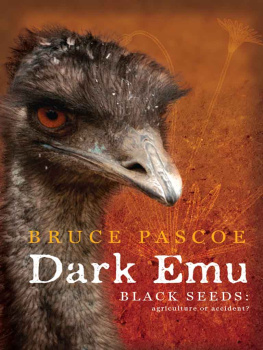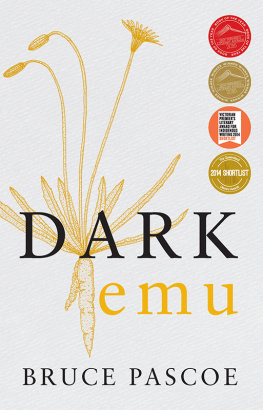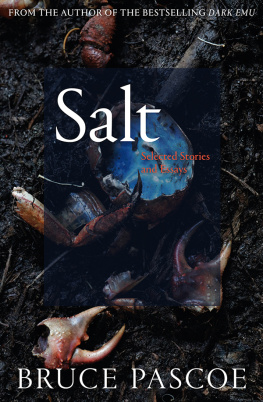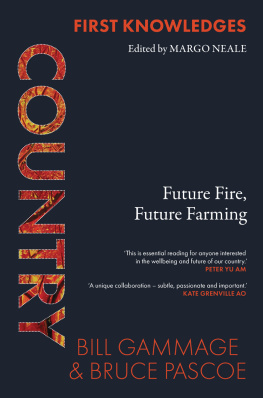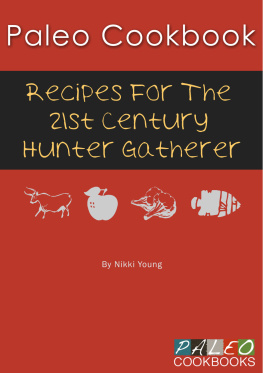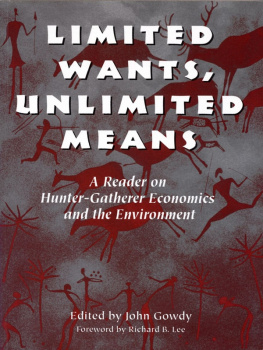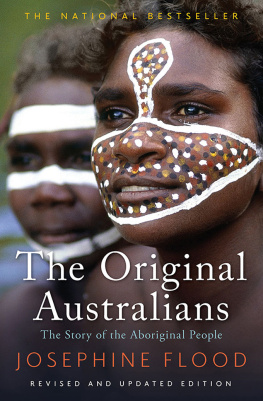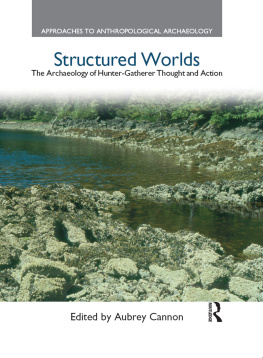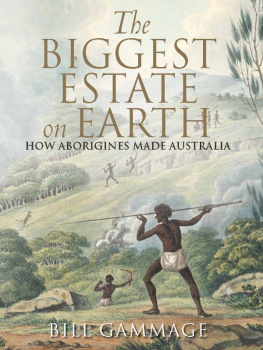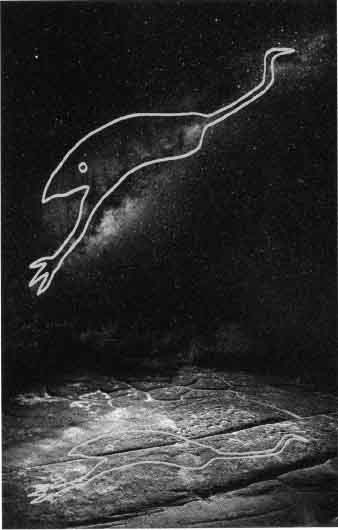
Rock Engraving of Emu Dreaming Ku-ring-gai Chase National Park, New South Wales
PHOTOGRAPH BARNABY NORRIS
Baiame, the creator Spirit Emu, left the earth after its creation to reside as a dark shape in the Milky Way. The emu is inextricably linked with the wide grasslands of Australia, the landscape managed by Aboriginals. The fate of the emu, people and grain are locked in step because, for Aboriginal people, the economy and the spirit are inseparable.
Europeans stare at the stars but Aboriginal people also see the spaces in between where the Spirit Emu resides.
| Other books by Bruce Pascoe |
| Novels: | Fox (Australian Bicentennial Novel; runner-up, 1988)
Ruby-eyed Coucal
Shark (FAW novel of the year, 1999)
Earth
Ocean
Ribcage (pseudonym Leopold Glass)
Bloke
Chainsaw File (young adult)
Fog, a Dox (young adult, Winner of 2013 Prime Ministers Award) |
| Story collections: |
Night Animals
Nightjar |
| History: |
Cape Otway: Coast of Secrets
Wathaurong: the people who said no
Convincing Ground |
| Children: |
| Foxies in a Firehose |

First published 2014 by Magabala Books Aboriginal Corporation, Broome, Western Australia
Website:
Magabala Books receives financial assistance from the Commonwealth Government through the Australia Council, its arts advisory body. The State of Western Australia has made an investment in this project through the Department of Culture and the Arts in association with Lotterywest.
Copyright Bruce Pascoe 2014
Copyright Images remain with individual owners All rights reserved. Apart from any fair dealing for the purposes of private study, research, criticism or review, as permitted under the Copyright Act, no part of this publication may be reproduced by any process whatsoever without the written permission of the publisher.
Designed by Tracey Gibbs
Printed in China at 1010 Printing International Ltd
Front cover photograph by Lyn Harwood
Illustration of yam and tuber by John Conran
Cataloguing-in-Publication Entry:
Author: | Pascoe, Bruce, 1947- author. |
Title: | Dark emu : black seeds agriculture or accident? /
Bruce Pascoe. |
ISBN: | 9781922142436 (paperback) |
Subjects: | Aboriginal Australians--Antiquities.
Aboriginal Australians--Social life and customs.
Aboriginal Australians--Agriculture.
Land use, Rural--Australia.
Hunting and gathering societies--Australia |
Dewey Number: 338.7630994

to the Australians
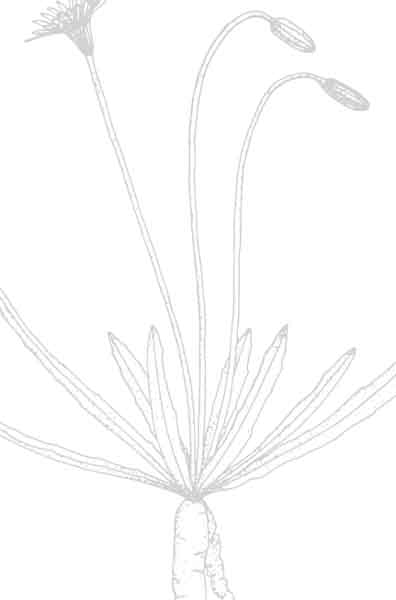
Contents
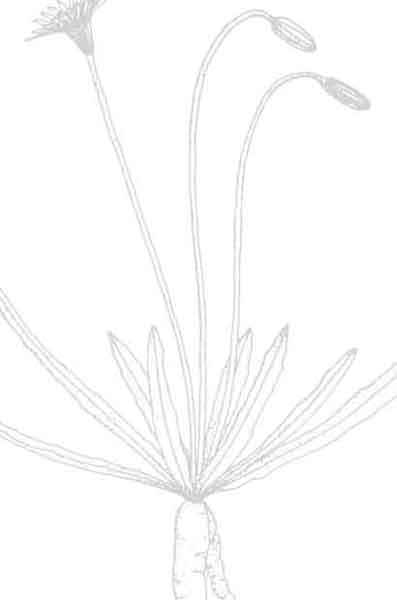
I am deeply indebted to Rupert Gerritsen for his book, Australia and the Origins of Agriculture. I found my way to that book by a Google search for Australian Aboriginal Grain Crops. It was listed number 35 in the search results and all previous listings referred to contemporary wheat crops, an indication of the poverty of analysis devoted to this topic.
Later in my search I came across an essay by Bill Gammage where he talked about Aboriginal gardening and farming. Gammages most recent book, The Biggest Estate, investigates, in exhaustive detail, the reports of early explorers and settlers, many of whom talked about the gentlemans estate they had chanced upon. Not a wilderness, not a land peopled by wanderers, but a managed landscape created by the enormous labour of a people intent on creating the best possible conditions for food production.
Im grateful to the ancestors for their ingenious protection of the land. Where else on earth was there a civilisation that lasted more than 60,000 years and depended on both agriculture and peace?
Many other people provided information and advice including: Gordon Briscoe, John Clarke, Neville Oddie, Lyn Harwood, Susan Pascoe, Jack Pascoe, Koorie Heritage Trust, Victorian Aboriginal Corporation for Languages, Brewarrina Cultural Centre, Brad Steadman, Sue Wesson, Lynnette Solomon-Dent, Vicki Couzens, Herb Patten, Michael Perry, Reg Couzens, Ted Donelan, Christina Eira, Stephen Morey, Ian Chivers, Charlotte Finch, Veronica Frail, Harry Allen, Paula Martin, The Artefact, Sue Norman, Betty Cruse, Liddy Stewart, Maria Brandl, Annette Peisley, Peter Gardiner, Ray Norris, John Morieson, Michael Walsh, St Kilda Indigenous Nursery Co-operative (SKINC), Russell Mullet, Beth Gott, Barrie Pittock, Kevin Lowe, Elaine van Kempen, Eric Rolls and many others.
Bruce Pascoe
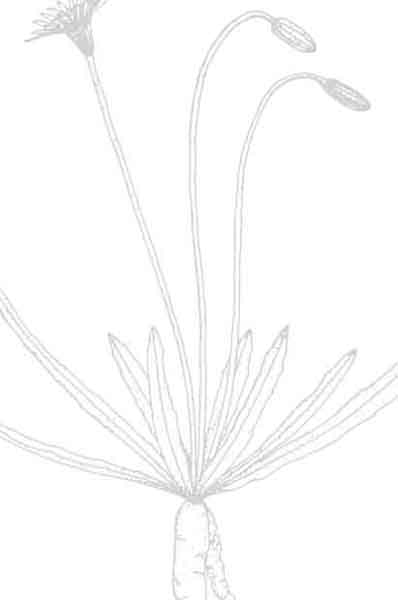
After my book on the Australian colonial frontier battles, Convincing Ground, was published in 2009, I was inundated with more than 200 letters and emails many of them from fourth generation farmers and Aboriginal people. Farmers sent me their great grandparents letters and documents about the frontier war and Aboriginal people sent new information on many of those same battles.
I already had a pile of information collected from research conducted too late to make it into Convincing Ground and after following the leads from correspondents I discovered much more.
I began to see a consistent thread running through the material; not only that the frontier war had been misrepresented in what we had been taught in school but also that the economy and culture of Aboriginal and Torres Strait Islander people had been grossly undervalued.
I knew that if I were to use all the new material in another book I would have to begin from the sources upon which Australias idea of history is based: the journals and diaries of explorers and colonists.
These journals revealed a much more complicated Aboriginal economy than the primitive hunter-gatherer lifestyle we had been told was the simple lot of Australias First People. Hunter-gatherer societies forage and hunt for food and do not employ agricultural methods or build permanent dwellings; they are nomadic. But as I read these early journals I came across repeated references to people building dams and wells, planting, irrigating and harvesting seed, preserving the surplus and storing it in houses, sheds or secure vessels, creating elaborate cemeteries and manipulating the landscape none of which fitted the definition of hunter-gatherer. Could it be that the accepted view of Indigenous Australians simply wandering from plant to plant, kangaroo to kangaroo in hapless opportunism was incorrect?
It is exciting to revisit the words of the first Europeans to witness the pre-colonial Aboriginal economy. In Dark Emu my aim is to give rise to the possibility of an alternative view of pre-colonial Aboriginal society. In reviewing the industry and ingenuity applied to food production over millennia, we have a chance to catch a glimpse of Australia as Aboriginals saw it.
Next page
